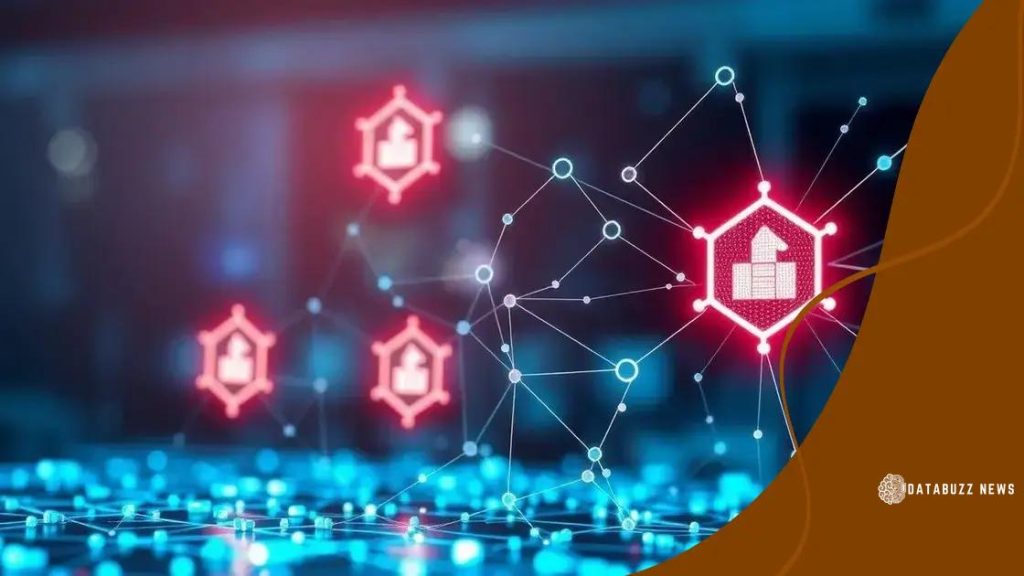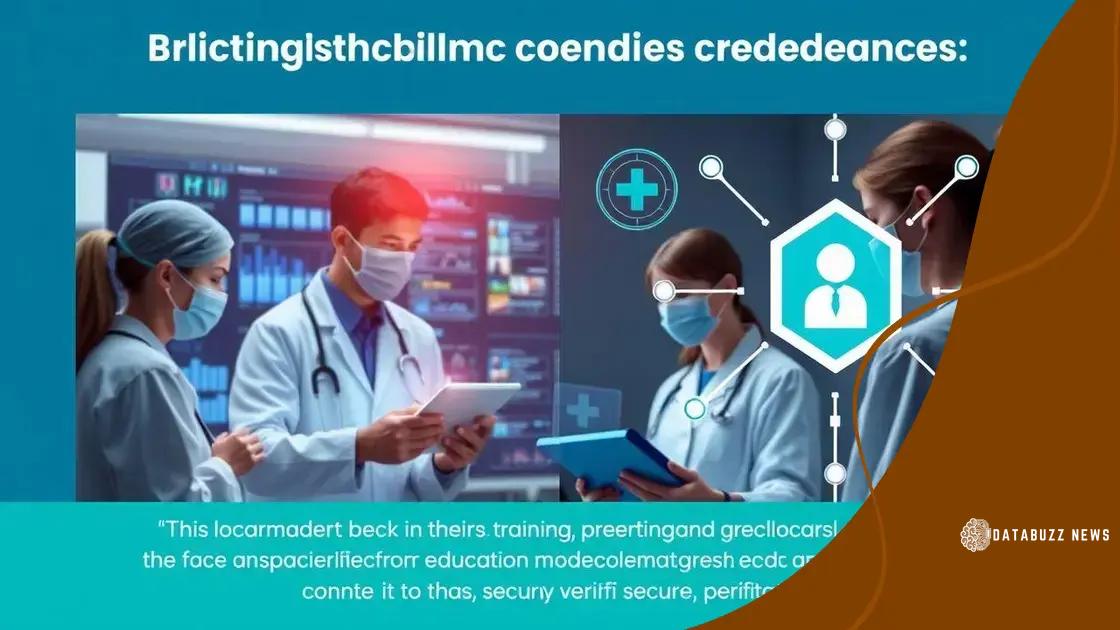Blockchain credentials for continuing medical education credits

Blockchain credentials for continuing medical education enhance security and trust by providing verifiable, tamper-proof records of educational achievements, facilitating real-time verification, and promoting lifelong learning among healthcare professionals.
Blockchain credentials for continuing medical education credits are changing how we think about verification in the medical field. Have you ever wondered how this technology ensures more secure and transparent educational achievements? Let’s dive in!
Understanding blockchain technology
Understanding blockchain technology is essential for grasping how it can revolutionize various fields, including education. This technology is more than just a buzzword; it represents a new way of storing information securely and transparently.
At its core, a blockchain is a digital ledger that records transactions across many computers. This means that once data is entered, it cannot be changed or deleted without consensus from the network. That’s why blockchain credentials are so powerful—they provide a tamper-proof way to verify achievements and qualifications.
Key Components of Blockchain
Several components work together to create a robust blockchain system. Understanding these can help clarify its value:
- Nodes: These are individual computers that maintain a copy of the blockchain.
- Blocks: Each block contains data, a timestamp, and a reference to the previous block.
- Consensus Mechanisms: This is how nodes agree on data validity, ensuring trust in the system.
Each of these components plays a vital role in the functionality and security of the blockchain. The decentralized nature of the technology means that no single authority controls the information, thereby reducing the risk of fraud.
Consider how other industries, like finance, use blockchain to track transactions and combat fraud. Similarly, in education, blockchain credentials ensure that the information about continuing medical education credits is both accurate and reliable.
How Blockchain Ensures Security
The security of blockchain technology lies in its architecture. By distributing data across a network of nodes, it becomes nearly impossible for any single entity to manipulate the information. With advanced cryptography, each transaction is locked in place and can only be accessed by authorized users.
As we look to the future, the potential for blockchain technology in medical education seems bright. The possibilities for enhancing trust and security in how credentials are managed can change the landscape for professionals and educational institutions alike. Knowing how this technology operates is the first step toward embracing its benefits.
The role of blockchain in medical education
The role of blockchain in medical education is significant as this technology offers innovative solutions for credential verification. Traditional forms of verification can be slow and prone to errors. However, blockchain streamlines this process, ensuring accuracy and security.
When institutions adopt blockchain, they create a permanent and unchangeable record of educational achievements. This is vital for medical education, where the credentials must reflect true capabilities. With blockchain, students and professionals can showcase their qualifications confidently.
Benefits of Blockchain in Medical Education
There are several advantages to using blockchain in this field:
- Enhanced Security: Information stored on the blockchain is protected from tampering.
- Interoperability: Different systems can easily share data, making the verification process faster.
- Decentralization: No single entity controls the information, reducing the risk of fraud.
These benefits contribute to creating a more trustworthy environment for medical professionals and educational institutions alike. Imagine the relief of knowing that your credentials are verified and accessible anytime, anywhere.
Furthermore, blockchain technology can update records in real-time. This means that as professionals continue their education, updates are immediately reflected on the blockchain. With continual learning being vital in the medical field, this feature enhances the relevance of credentials.
Challenges of Implementing Blockchain
Despite its benefits, implementing blockchain in medical education does come with challenges. Initial costs for integrating this technology can be high, which might deter some institutions. Additionally, there is a need for training staff to manage and use blockchain effectively.
The lack of standardization across educational institutions can also create obstacles. However, once these challenges are addressed, the long-term benefits of blockchain will greatly outweigh the initial hurdles.
Benefits of blockchain credentials

Benefits of blockchain credentials are numerous and impactful, particularly in the medical education field. By using blockchain technology, institutions can secure a reliable verification system for educational achievements.
These credentials offer unmatched security since they are stored on a decentralized network. This means that the risk of tampering or fraud is significantly reduced. For healthcare professionals, this aspect is vital as maintaining integrity in qualifications can directly impact patient care.
Key Advantages of Using Blockchain Credentials
Implementing blockchain technology for credentials provides several key advantages:
- Instant Verification: Employers can verify credentials in real-time, speeding up hiring processes.
- Reduced Costs: With less need for third-party verification services, institutions save money.
- Improved Transparency: Every transaction is recorded on a public ledger, ensuring that all data can be traced back to its source.
This transparency builds trust among institutions, employers, and students. Knowing that a credential is verified through a secure system encourages more medical professionals to pursue further education.
In addition to the security and transparency, blockchain credentials also simplify the process of maintaining and updating achievements. As professionals engage in continuing education, their records can be updated automatically and reflected on the blockchain. This ensures that every medical professional’s credentials remain current without the cumbersome process of manual updates.
Enhancing Career Opportunities
For individuals, the benefits of blockchain credentials extend to career advancement. Having a verified and easily accessible record increases professional credibility. Employers are more likely to consider candidates with blockchain-secured credentials, knowing they can trust the validation of their skills and education.
Moreover, patients benefit indirectly from this system as well. When healthcare professionals have secure and verified credentials, patients can have greater confidence in the care they receive. This creates a positive cycle where trust and quality in healthcare are improved.
Challenges of implementing blockchain
Challenges of implementing blockchain technology in medical education can be significant, although the benefits are substantial. Understanding these challenges helps institutions prepare for a smoother integration process.
One of the main hurdles is the initial cost of adopting blockchain. Setting up the infrastructure requires investment in both technology and training. Many institutions may hesitate due to the financial commitment required to implement a new system.
Technological Barriers
The technical aspects of blockchain can also pose challenges. Institutions may lack the necessary expertise to effectively manage and operate blockchain systems. This might lead to improper implementations that fail to meet their intended goals.
- Lack of Standardization: There are many different blockchain systems, and without a standard approach, integration can be complex.
- Interoperability Issues: Different platforms may not work well together, complicating the sharing of data between educational institutions.
- Data Privacy Concerns: Ensuring that sensitive information remains protected while being stored on a public ledger is a key concern.
Additionally, the regulatory landscape surrounding blockchain is still evolving. Many regions lack clear guidelines on how blockchain technology should be used in education and healthcare, leading to uncertainties for institutions considering adoption.
The lack of understanding about blockchain among stakeholders can further complicate the process. Without education on the value and importance of this technology, decision-makers may be reluctant to invest in it.
Overcoming Implementation Challenges
Despite these challenges, many institutions are optimistic about the potential of blockchain. Collaborating with technology experts can help ensure proper implementation. This partnership can also provide ongoing education for staff, which is crucial for maximizing the technology’s benefits.
Ultimately, addressing these challenges head-on can pave the way for successful adoption in medical education, allowing institutions to harness the power of blockchain to improve credential verification and trust in the educational system.
Future trends in continuing medical education
Future trends in continuing medical education are evolving rapidly, especially with the integration of innovative technologies like blockchain. As the healthcare landscape changes, medical education must also adapt to meet new challenges.
One significant trend is the increase in online learning platforms. These platforms allow healthcare professionals to access educational resources anytime and anywhere. This flexibility is especially important for busy doctors and nurses who need to balance work and education. With the rise of technology, we can expect more interactive and engaging formats in online courses.
Integration of Blockchain Technology
Blockchain will play a crucial role in shaping the future of continuing medical education. It ensures secure and verifiable credentials for professionals. This security will enhance trust in online courses and certifications. Institutions will be able to track a learner’s progress efficiently.
- Personalized Learning: With data analytics, educational content can be tailored to individual needs.
- Micro-credentialing: Short, focused courses will become more popular, allowing professionals to earn qualifications quickly.
- Global Collaboration: Increased connectivity will allow institutions to collaborate globally, offering diverse perspectives.
As we move forward, it is essential for educational institutions to embrace these technologies. Continuing medical education will increasingly focus on building skills that align with real-world applications. This approach ensures healthcare professionals are not just knowledgeable but also equipped to handle practical challenges.
Importance of Lifelong Learning
Lifelong learning will continue to be a key theme in medical education. As medicine progresses, ongoing training becomes vital. Healthcare providers must stay updated on the latest technologies, treatments, and regulations. This commitment to learning fosters a culture of excellence in the medical field.
In summary, the future of continuing medical education looks promising with the integration of technology. Blockchain offers the potential to secure credentials, while online learning provides flexibility for professionals. By staying adaptable and embracing new trends, the healthcare industry can ensure that its workforce remains prepared to provide high-quality care.
FAQ – Frequently Asked Questions about Blockchain in Continuing Medical Education
What is blockchain technology?
Blockchain is a digital ledger that securely records information across many computers, ensuring data cannot be changed without consensus.
How does blockchain benefit medical education?
Blockchain offers secure verification of educational credentials, reducing fraud and increasing trust among employers and institutions.
What are the challenges of implementing blockchain?
Challenges include high initial costs, a lack of standardization, and the need for staff training to effectively manage the technology.
Why is lifelong learning important in healthcare?
Lifelong learning is crucial for healthcare professionals to keep up with advancements in medicine, ensuring they provide the best care possible.
